Page 118 of 186
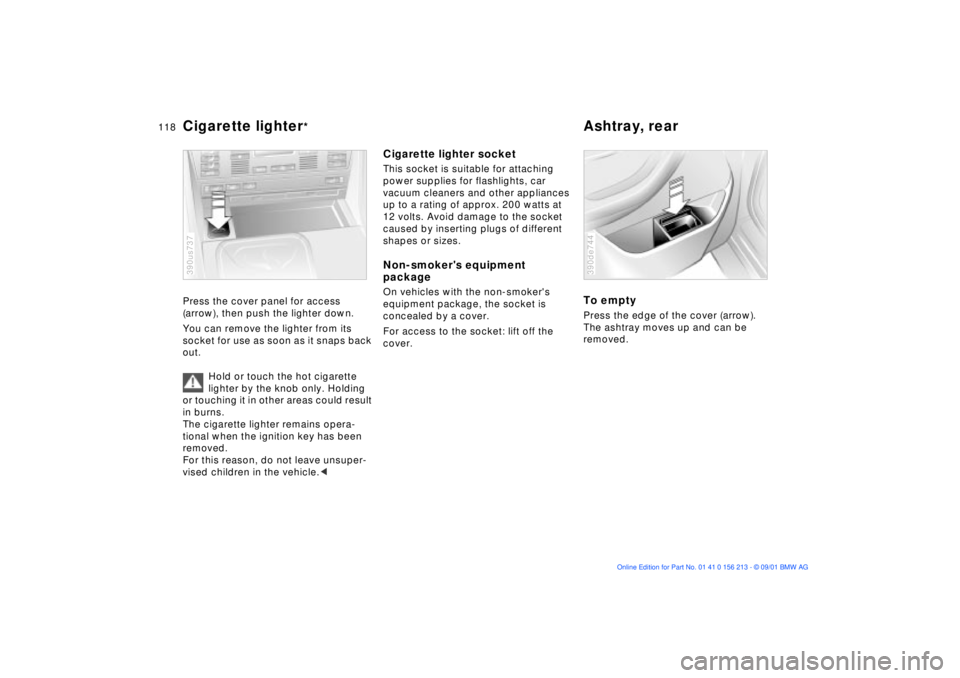
118n
Cigarette lighter
*
Ashtray, rear
Press the cover panel for access
(arrow), then push the lighter down.
You can remove the lighter from its
socket for use as soon as it snaps back
out.
Hold or touch the hot cigarette
lighter by the knob only. Holding
or touching it in other areas could result
in burns.
The cigarette lighter remains opera-
tional when the ignition key has been
removed.
For this reason, do not leave unsuper-
vised children in the vehicle.< 390us737
Cigarette lighter socketThis socket is suitable for attaching
power supplies for flashlights, car
vacuum cleaners and other appliances
up to a rating of approx. 200 watts at
12 volts. Avoid damage to the socket
caused by inserting plugs of different
shapes or sizes.Non-smoker's equipment
packageOn vehicles with the non-smoker's
equipment package, the socket is
concealed by a cover.
For access to the socket: lift off the
cover.
To emptyPress the edge of the cover (arrow).
The ashtray moves up and can be
removed.390de744
Page 119 of 186
119n
OverviewControlsMaintenanceRepairsDataIndex
Through-loading system
*
Fold the rear backrests downReach into the recess and pull forward
(arrow 1).
When you close the backrest, be sure
that the catch engages securely. The
red slide (arrow 2) must go underneath.394de745
The central belt has an additional small
buckle.
>If you connect the two belt sections,
you can use the central belt as any
normal 3-point belt
>It is easier to fold the rear-seat back-
rest up and down if you unbuckle the
belt (arrow).394de746
With a master key, you can lock each
backrest in the rear seat.
This also prevents access to the
luggage compartment from the interior
of the vehicle when you turn over the
door and ignition key 3 to someone else
(refer to page 32), for valet parking, etc.394de747
Page 125 of 186
125n
OverviewControlsMaintenanceRepairsDataIndex
Luggage compartment Ð sport wagonFloor compartmentTo release: press the handle in the
recess and fold the cover upward on
the handle (large arrow).
You can lock the cover with a master
key.
The dividers in the compartment can be
rearranged. If you remove the divider
and turn the divider retainer to the left
and remove it, you have a level storage
compartment.392de779
Fold the floor cover upLift up the black retainer on the lower
side of the panel and hook it into the
upper frame of the tailgate cutout.
Before you fold the floor cover down,
return the retainer to its original posi-
tion.392de168
Fold up the spare tire coverLift up the cover and hook it into the red
retainer on the floor panel (arrow).
Before you fold the cover down, return
the retainer to its original position.392de169
Page 156 of 186
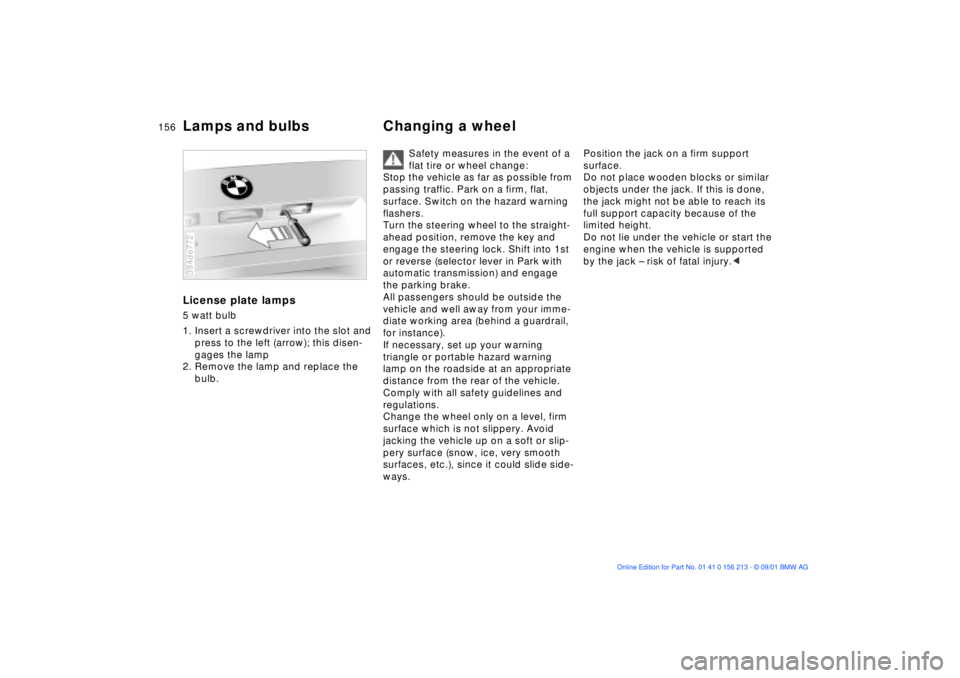
156n
Lamps and bulbs Changing a wheelLicense plate lamps5 watt bulb
1. Insert a screwdriver into the slot and
press to the left (arrow); this disen-
gages the lamp
2. Remove the lamp and replace the
bulb.394de772
Safety measures in the event of a
flat tire or wheel change:
Stop the vehicle as far as possible from
passing traffic. Park on a firm, flat,
surface. Switch on the hazard warning
flashers.
Turn the steering wheel to the straight-
ahead position, remove the key and
engage the steering lock. Shift into 1st
or reverse (selector lever in Park with
automatic transmission) and engage
the parking brake.
All passengers should be outside the
vehicle and well away from your imme-
diate working area (behind a guardrail,
for instance).
If necessary, set up your warning
triangle or portable hazard warning
lamp on the roadside at an appropriate
distance from the rear of the vehicle.
Comply with all safety guidelines and
regulations.
Change the wheel only on a level, firm
surface which is not slippery. Avoid
jacking the vehicle up on a soft or slip-
pery surface (snow, ice, very smooth
surfaces, etc.), since it could slide side-
ways.
Position the jack on a firm support
surface.
Do not place wooden blocks or similar
objects under the jack. If this is done,
the jack might not be able to reach its
full support capacity because of the
limited height.
Do not lie under the vehicle or start the
engine when the vehicle is supported
by the jack Ð risk of fatal injury.<
Page 164 of 186
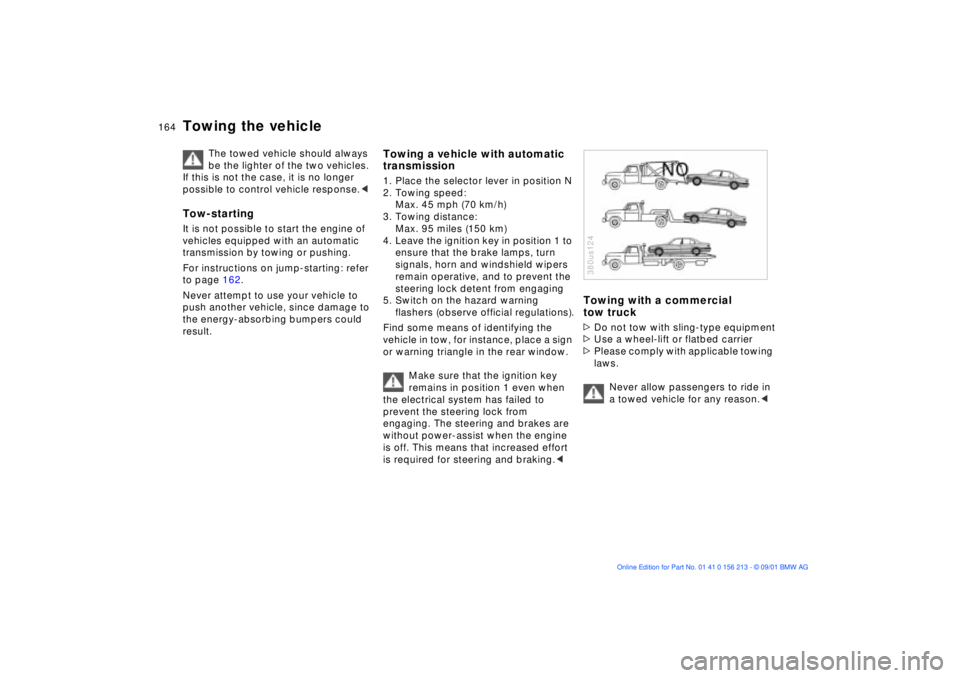
164n
Towing the vehicle
The towed vehicle should always
be the lighter of the two vehicles.
If this is not the case, it is no longer
possible to control vehicle response.<
Tow-startingIt is not possible to start the engine of
vehicles equipped with an automatic
transmission by towing or pushing.
For instructions on jump-starting: refer
to page 162.
Never attempt to use your vehicle to
push another vehicle, since damage to
the energy-absorbing bumpers could
result.
Towing a vehicle with automatic
transmission1. Place the selector lever in position N
2. Towing speed:
Max. 45 mph (70 km/h)
3. Towing distance:
Max. 95 miles (150 km)
4. Leave the ignition key in position 1 to
ensure that the brake lamps, turn
signals, horn and windshield wipers
remain operative, and to prevent the
steering lock detent from engaging
5. Switch on the hazard warning
flashers (observe official regulations).
Find some means of identifying the
vehicle in tow, for instance, place a sign
or warning triangle in the rear window.
Make sure that the ignition key
remains in position 1 even when
the electrical system has failed to
prevent the steering lock from
engaging. The steering and brakes are
without power-assist when the engine
is off. This means that increased effort
is required for steering and braking.<
Towing with a commercial
tow truck>Do not tow with sling-type equipment
>Use a wheel-lift or flatbed carrier
>Please comply with applicable towing
laws.
Never allow passengers to ride in
a towed vehicle for any reason.< 380us124
Page 175 of 186
175n
OverviewControlsMaintenanceRepairsDataIndex
Overview
Controls and features
Operation, maintenance
Owner service procedures
Index Technical data
Key words
Page 177 of 186
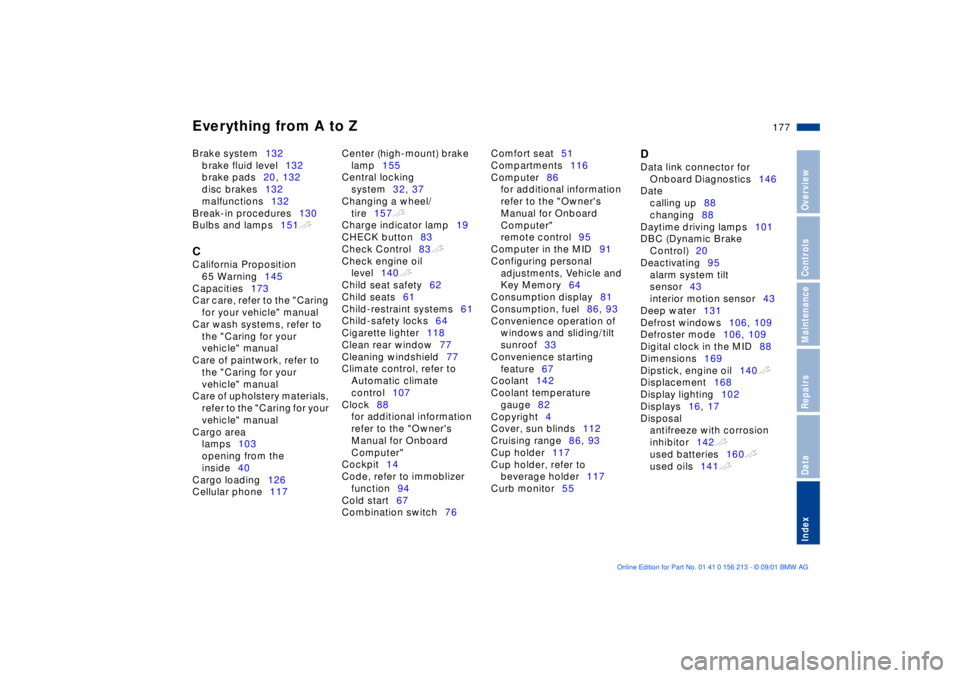
Everything from A to Z
177n
OverviewControlsMaintenanceRepairsDataIndex
Brake system132
brake fluid level132
brake pads20, 132
disc brakes132
malfunctions132
Break-in procedures130
Bulbs and lamps151t C
California Proposition
65 Warning145
Capacities173
Car care, refer to the "Caring
for your vehicle" manual
Car wash systems, refer to
the "Caring for your
vehicle" manual
Care of paintwork, refer to
the "Caring for your
vehicle" manual
Care of upholstery materials,
refer to the "Caring for your
vehicle" manual
Cargo area
lamps103
opening from the
inside40
Cargo loading126
Cellular phone117 Center (high-mount) brake
lamp155
Central locking
system32, 37
Changing a wheel/
tire157t
Charge indicator lamp19
CHECK button83
Check Control83t
Check engine oil
level140t
Child seat safety62
Child seats61
Child-restraint systems61
Child-safety locks64
Cigarette lighter118
Clean rear window77
Cleaning windshield77
Climate control, refer to
Automatic climate
control107
Clock88
for additional information
refer to the "Owner's
Manual for Onboard
Computer"
Cockpit14
Code, refer to immoblizer
function94
Cold start67
Combination switch76 Comfort seat51
Compartments116
Computer86
for additional information
refer to the "Owner's
Manual for Onboard
Computer"
remote control95
Computer in the MID91
Configuring personal
adjustments, Vehicle and
Key Memory64
Consumption display81
Consumption, fuel86, 93
Convenience operation of
windows and sliding/tilt
sunroof33
Convenience starting
feature67
Coolant142
Coolant temperature
gauge82
Copyright4
Cover, sun blinds112
Cruising range86, 93
Cup holder117
Cup holder, refer to
beverage holder117
Curb monitor55
D
Data link connector for
Onboard Diagnostics146
Date
calling up88
changing88
Daytime driving lamps101
DBC (Dynamic Brake
Control)20
Deactivating95
alarm system tilt
sensor43
interior motion sensor43
Deep water131
Defrost windows106, 109
Defroster mode106, 109
Digital clock in the MID88
Dimensions169
Dipstick, engine oil140t
Displacement168
Display lighting102
Displays16, 17
Disposal
antifreeze with corrosion
inhibitor142t
used batteries160t
used oils141t
Page 179 of 186
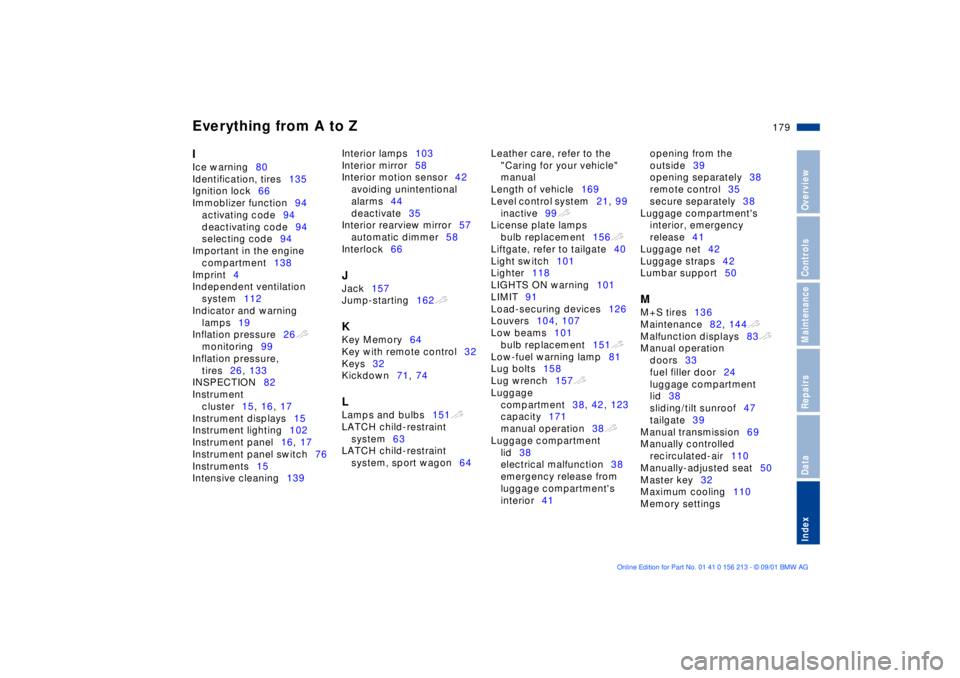
Everything from A to Z
179n
OverviewControlsMaintenanceRepairsDataIndex
I
Ice warning80
Identification, tires135
Ignition lock66
Immoblizer function94
activating code94
deactivating code94
selecting code94
Important in the engine
compartment138
Imprint4
Independent ventilation
system112
Indicator and warning
lamps19
Inflation pressure26t
monitoring99
Inflation pressure,
tires26, 133
INSPECTION82
Instrument
cluster15, 16, 17
Instrument displays15
Instrument lighting102
Instrument panel16, 17
Instrument panel switch76
Instruments15
Intensive cleaning139 Interior lamps103
Interior mirror58
Interior motion sensor42
avoiding unintentional
alarms44
deactivate35
Interior rearview mirror57
automatic dimmer58
Interlock66
J
Jack157
Jump-starting162t K
Key Memory64
Key with remote control32
Keys32
Kickdown71, 74 L
Lamps and bulbs151t
LATCH child-restraint
system63
LATCH child-restraint
system, sport wagon64 Leather care, refer to the
"Caring for your vehicle"
manual
Length of vehicle169
Level control system21, 99
inactive99t
License plate lamps
bulb replacement156t
Liftgate, refer to tailgate40
Light switch101
Lighter118
LIGHTS ON warning101
LIMIT91
Load-securing devices126
Louvers104, 107
Low beams101
bulb replacement151t
Low-fuel warning lamp81
Lug bolts158
Lug wrench157t
Luggage
compartment38, 42, 123
capacity171
manual operation38t
Luggage compartment
lid38
electrical malfunction38
emergency release from
luggage compartment's
interior41 opening from the
outside39
opening separately38
remote control35
secure separately38
Luggage compartment's
interior, emergency
release41
Luggage net42
Luggage straps42
Lumbar support50
M
M+S tires136
Maintenance82, 144t
Malfunction displays83t
Manual operation
doors33
fuel filler door24
luggage compartment
lid38
sliding/tilt sunroof47
tailgate39
Manual transmission69
Manually controlled
recirculated-air110
Manually-adjusted seat50
Master key32
Maximum cooling110
Memory settings